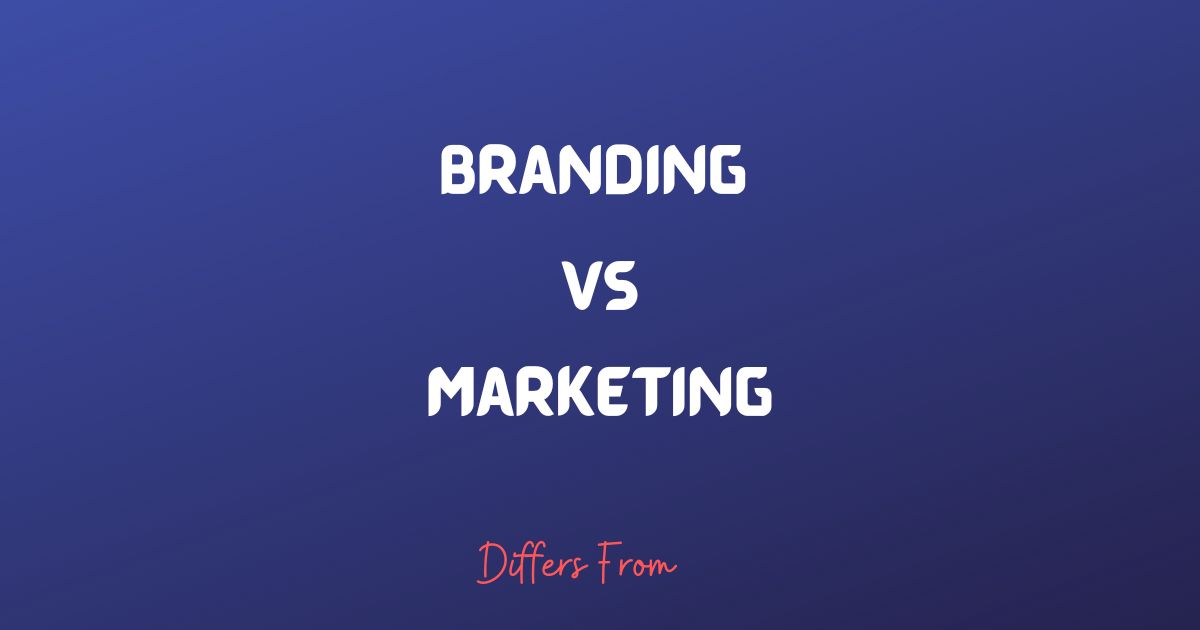In the world of business, branding, and marketing are often used interchangeably. However, understanding the fundamental distinctions between these two strategies is crucial for achieving long-term success. Let’s explore the key difference between branding and marketing and how they shape the destiny of businesses.
Difference between branding and marketing
| Branding | Marketing |
| Focuses on creating a unique identity and perception for a product, service, or company. | Involves strategies and activities to promote products, services, or brands. |
| It aims to evoke emotions, build trust, and foster long-term customer loyalty. | Generates customer interest and drives sales. |
| Establishes a distinct personality, image, and reputation to differentiate from competitors. | Communicates the value and benefits of offerings to the target market. |
| Shapes the overall reputation and image of a brand. | Focuses on achieving short-term objectives like increasing sales and market share. |
| A long-term endeavor that focuses on creating a lasting impression. | Immediate and short-term in nature. |
| Encompasses brand positioning, messaging, visual identity, and brand experiences. | Encompasses pricing, distribution, advertising, sales promotions, and public relations. |
| Influences product development, customer service, and employee behavior. | Includes market research, identifying target audiences, and creating marketing plans. |
| Provides the foundation for marketing efforts. | Supports branding efforts by promoting the brand and its offerings. |
| Creates a strong brand that already has a loyal customer base and favorable market perception. | Executes specific campaigns and initiatives to drive business results. |
Branding VS Marketing
Definition
Branding
Branding creates a unique identity and perception for a product, service, or company. It involves crafting a distinct personality, image, and reputation that differentiates it from competitors.
Marketing
Marketing refers to the strategies and activities aimed at promoting products, services, or brands to target audiences. It involves various tactics to generate awareness, drive sales, and build customer relationships.
Purpose and Objectives
Branding
The primary purpose of branding is to establish a solid and recognizable brand identity.
It aims to create a positive perception, evoke emotions, build trust, and foster long-term customer loyalty. Branding focuses on shaping the overall reputation and image of a brand.
Marketing
Marketing aims to promote products or services, generate customer interest, and drive sales.
It aims to communicate the value and benefits of offerings to the target market. Marketing focuses on achieving short-term objectives like increasing sales and market share.
Time Horizon
Branding
Branding is a long-term endeavor to create a lasting impression and reputation. It aims to build a strong brand over time and maintain consistency in messaging, design, and customer experience.
Marketing
Marketing activities are more immediate and short-term in nature. They are geared towards achieving specific objectives, such as increasing sales during a promotional campaign or launching a new product successfully.
Scope
Branding
Branding encompasses the overall brand strategy, including brand positioning, brand personality, brand messaging, visual identity (logo, design, color schemes), brand voice, and brand experiences.
It influences all aspects of the brand, including product development, customer service, and employee behavior.
Marketing
Marketing includes a broader range of activities such as market research, identifying target audiences, creating marketing plans, pricing, distribution, advertising, sales promotions, public relations, and digital marketing.
It focuses on the tactical execution of specific campaigns and initiatives.
Relationship
Branding
Branding provides the foundation for marketing efforts by creating a solid brand identity and reputation.
A well-established brand can make marketing initiatives more effective as it already has a loyal customer base and a favorable market perception.
Marketing
Marketing activities support branding efforts by promoting the brand and its offerings to the target audience.
Marketing campaigns help create awareness, generate leads, and drive sales, contributing to the overall growth and success of the brand.
What is branding?
Branding refers to creating a distinct and recognizable identity for a product, service, or company.
It involves crafting a unique combination of name, logo, design, messaging, and overall image that sets it apart from competitors.
Effective branding aims to establish a positive perception, evoke emotions, build trust, and create customer loyalty, ultimately influencing consumer decisions and fostering long-term relationships.
Pros of Branding
- Differentiation: Branding helps differentiate a product, service, or company from competitors, creating a unique identity and standing out in the market.
- Customer Loyalty: Effective branding builds customer loyalty by creating an emotional connection, trust, and preference for the brand, leading to repeat purchases and advocacy.
- Price Premium: Strong brands often command a premium, allowing companies to charge higher prices than competitors offering similar products or services.
- Competitive Advantage:
A well-established brand is a competitive advantage, making it harder for competitors to replicate or surpass its reputation and customer loyalty.
Cons of Branding
- Time and Investment: Building a solid brand requires time, effort, and significant investment in brand development, advertising, and marketing activities.
- Risk of Brand Dilution: If not managed carefully, brand extensions or diversification can dilute the brand’s core identity and confuse consumers.
- Brand Perception Challenges: Negative events, poor customer experiences, or public relations issues can damage a brand’s reputation, requiring significant efforts to rebuild trust.
What is marketing?
Marketing encompasses a range of strategies and activities aimed at promoting products, services, or brands to target audiences.
It involves market research, identifying customer needs, developing marketing plans, pricing, distribution, advertising, and communication channels.
Marketing aims to generate awareness, drive sales, and build customer relationships through various tactics like advertising, sales promotions, public relations, and digital marketing.
Pros of Marketing
- Increased Awareness: Marketing activities help generate awareness of a product, service, or brand among target audiences, expanding its reach and visibility.
- Sales Growth: Effective marketing strategies can increase sales and revenue by driving customer interest, creating demand, and influencing purchase decisions.
- Market Research Insights: Marketing involves conducting market research, which provides valuable insights into customer needs, preferences, and market trends, helping companies make informed business decisions.
- Competitive Edge: Well-executed marketing campaigns can give a competitive edge by highlighting unique selling propositions and favorably positioning a product or brand against competitors.
Cons of Marketing
- Costly Investment: Marketing efforts often require significant financial resources for advertising, promotions, and marketing campaigns, which can strain a company’s budget.
- Uncertain Results: Despite careful planning, marketing outcomes can be unpredictable, making it challenging to guarantee a positive return on investment.
- Saturation and Clutter: In a crowded marketplace, consumers are exposed to numerous marketing messages, leading to saturation and clutter, making it harder for brands to break through and capture attention.
If you want to know more about today’s marketing, you can read more about Traditional Marketing and Data-Driven Digital Marketing
Conclusion
Branding focuses on creating a unique identity, perception, and reputation for a product or company, fostering long-term loyalty. Conversely, marketing involves strategies and activities to promote products or services, driving short-term sales and customer engagement. Both are integral for business success.

